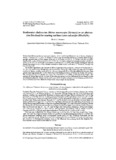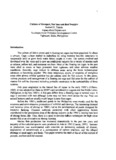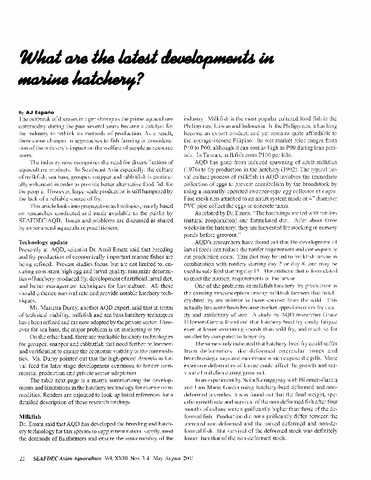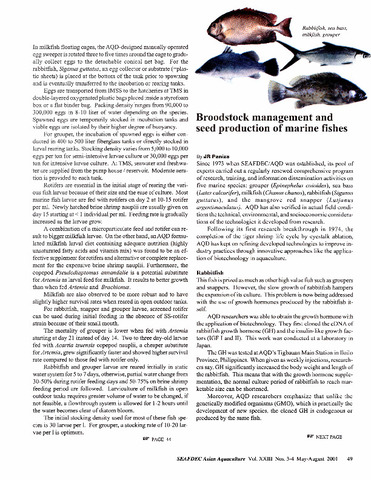Freshwater cladoceran Moina macrocopa (Strauss) as an alternative live food for rearing sea bass Lates calcarifer (Bloch) fry
Share
Abstract
Fifteen day old sea bass larvae were acclimated to 10‰ S and fed ad libitum levels of Moina, Artemia or Moina + Artemia (at 1:1 ratio). Fish kept at 32 ‰ S and fed Artemia served as a control. After 20 days, specific growth rates of fish ranged from 8.8 ± 2.5%/ day to 12.9 ± 1.4%/day and did not differ significantly in any of the treatments (P > 0.05). Survival rates of fish fed Artemia in either 10 (26.9 ± 8.4%) or 32 (30.2 ± 12.8 %)‰ S and Moina+Artemia (7.7 ± 2.8%) were similar and higher than the Moina-fed group (2.6 ± 1.4%). Results seemed to relate to poor utilization of Moina by younger sea bass (15-day-old).
In another experiment, the amount of Moina ingested in the presence or absence of Artemia by 15-, 20-, 25-, 30-, and 35-day-old sea bass was determined. Thirty-day-old sea bass fry ingested the highest number of Moina, whether with (17.19 ± 1.96) or without (25.29 ± 2.93) the addition of Artemia, than did the other age-groups (P < 0.05). There was a low feeding incidence of Moina by 15-day-old sea bass. The number of ingested Moina was positively correlated (r = 0.6358) to the fish body length. The amount of Moina ingested by sea bass of the same age group was not influenced by the length of time after feed introduction. Moina can be used as partial or complete substitutes for Artemia, provided they are sieved beforehand for efficient utilization by the younger sea bass larvae.
Suggested Citation
Fermin, A. C. (1991). Freshwater cladoceran Moina macrocopa (Strauss) as an alternative live food for rearing sea bass Lates calcarifer (Bloch) fry. Journal of Applied Ichthyology , 7(1), 8-14. https://doi.org/10.1111/j.1439-0426.1991.tb00589.x
Subject
Taxonomic term
Collections
- AQD Journal Articles [1248]
Related items
Showing items related by title, author, creator and subject.
-
Culture of grouper, sea bass and red snapper
Toledo, Joebert D. (University of the Philippines Aquaculture Society, Inc., 2001)Marine fish production has increased dramatically in the past ten years and majority of the cultured species were produced in Asia in 1992. Increase in production was accompanied with concerns on increasing outbreak of ... -
What are the latest developments in marine hatchery?
Españo, A. J. (Aquaculture Department, Southeast Asian Fisheries Development Center, 2001) -
Broodstock management and seed production of marine fishes
Paniza, J. R. (Aquaculture Department, Southeast Asian Fisheries Development Center, 2001)




